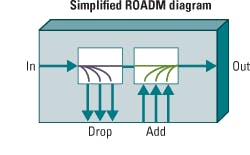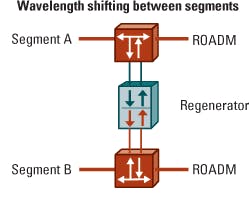by Leo Goyette
Metro-area optical networks are far more dynamic today than they were a decade ago. Although much has been written about the demise of SONET/SDH and the dominance of Ethernet, it appears they, along with several other protocols, will be around for the foreseeable future. What is more difficult to determine for optical network service providers is which protocols and services their customers will demand from them and what new services are just over the horizon.
There are some things, however, that are unlikely to change: quality of service (QoS) requirements, greater bandwidth demands, and decreasing margins. In short, customers want more bandwidth and higher quality; they don�t want to pay more for it, and they want it now.
One way to resolve these issues is to build a network that is flexible, dynamic, and able to accommodate the inevitable changes in technology. Removing protocol dependency from the equation, while adding the ability to increase bandwidth on demand, is a step in this direction. While we�re at it, let�s minimize those annoying (and expensive) truck rolls as well.
A protocol-independent reconfigurable optical transport network (PIROTN) consists of a number of network elements connected by fiber links (Fig. 1). The network transports client signals using DWDM, providing management, monitoring, routing, and resiliency. Two distinguishing features are its protocol independence and client data transparency.
As optical networks evolve toward all-optical transport, networks built on protocol-dependent equipment will have to be continually upgraded to reflect customer protocol and bandwidth requirements. Removing protocol dependency provides greater flexibility by pushing protocol-dependent equipment to the network edge, even to the point of customer self-installation.Another benefit of pushing protocol dependence to the network edge and adding remote reconfiguration capability is the ability to create bandwidth on demand. Once protocol dependence is relegated to the edge of the network, the transport provider configures a �pipe� from source to destination via the network element management system (EMS). If a customer desires more bandwidth, the network may not have to be reconfigured at all�only the equipment at the respective ends of the �pipe� would need to be reconfigured. At this point the customer may be able to perform the �install,� avoiding a truck roll altogether.
Protocol-independent protection switching occurs based on the optical signal routed through the network elements and alarms raised either by the protocol-dependent demarcation equipment on the edge of the network or by customer premises equipment itself, depending on the network configuration.
Protection switching based on the optical signal occurs when the signal strength falls below a certain threshold. This may be due to a fiber cut but may also be due to signal degradation. Once the protection switch is made, an alarm is raised to notify the network operator an event has occurred.
Protocol-dependent network demarcation equipment at the edge of the network may also raise an alarm. In this event the alarm may be routed to the EMS for operator intervention (a manual reroute) or, for quicker recovery, the alarm may be sent to the appropriate network element, causing the element to trigger a protection switch.
In any event, the protection switches can be reverting or nonreverting just as in protocol-dependent protection switching.
To provide bandwidth on demand along with the protocol independence, several other technologies are required: forward error correction (FEC), reconfigurable optical add/drop multiplexers (ROADMs), amplifiers, and regenerators/repeaters.
OTN and FEC. While the �OTN� in PIROTN does not refer to the OTN defined in the ITU�s G.709 specification, it shares several useful features. A G.709 wrapper (sometimes referred to as an OTU1 or OTU2 wrapper for reasons outside the scope of this article) provides FEC along with several other features such as performance monitoring, communication channels, and tandem connection monitoring.
The lower bit-error rate (BER) inherent in the OTN design due to its use of FEC provides greater data integrity to the customer. That, coupled with the performance monitoring in the protocol and the end-to-end communication capabilities, allows network operators to provide better QoS to the end customer.
As data rates increase, data integrity becomes even more critical. A G.709 wrapper provides protocols such as Ethernet with SONET-like performance monitoring and alarms, while maintaining client data transparency.
How does OTN help provide protocol transparency? By using protocol-independent repeaters and terminals, the client data becomes immaterial to the operation of the network, and the built-in communication and performance monitoring provide the information needed for end-to-end service.
ROADMs. A full description of what ROADMs are and what they do would be too lengthy for this article. In short, they perform optical switching rather than OEO switching. There are colorless multidegree ROADMs, which can be thought of as reconfigurable optical crossconnects, and wavelength (though not protocol) dependent ROADMs, which require a fixed channel plan.
ROADMs can direct one or more wavelengths to one or more ports to create a redundant mesh network, provide network redundancy, or simple drop and add wavelengths into a network (Fig. 2). If CALEA compliance is on your agenda, ROADMs can help there as well.
ROADMs provide the necessary capability for dynamic, protocol-independent network growth, network resilience, and bandwidth on demand.
It may be obvious, but routing signals at the optical level removes protocol dependences entirely from the equation. Using ROADMs also allows the network to add segments on demand simply by dropping additional wavelengths when and where needed.
Optical amplifiers. These elements aren�t new or sexy, but they are nevertheless invaluable components in a PIROTN. Optical amplifiers not only extend the reach of the network but they also compensate for loss due to fiber length, passing through a ROADM, or dispersion compensation. By amplifying signals at the optical level the protocol becomes immaterial.Amplifiers designed for a PIROTN are able to compensate for the increase or decrease in the number of wavelengths by adjusting power output without disrupting the rest of the network.
Protocol-independent regenerators. Protocol-independent regenerators serve several purposes in the PIROTN beyond simple 3R regeneration. They can also provide mid-span repeater functionality, wavelength shifting, and terminal functions such as adding and stripping the G.709 wrapper. They can act as demarcation devices as well.
The latest regenerators support multiple protocols and are tunable. Changing protocols and wavelengths is a simple matter of issuing a software command. In terminal or edge mode, these devices can add and strip the G.709 wrapper from the client signal.
Another benefit of tunable regenerators is the ability to change wavelengths when a ROADM is used to connect two network segments (Fig. 3). A signal routed from one network segment to another may be on ITU channel 22 in segment A, yet that wavelength may be in use in segment B. By routing the signal through a tunable regenerator, the wavelength can be shifted to another channel, such as ITU channel 31.
Here the protocol independence is due to the multiprotocol support provided by the regenerators, and tunability provides the necessary reconfiguration.
Network service providers cannot afford to rip up their networks as they move forward with new products and services. Moving to protocol independence does not require removing existing equipment; it�s a matter of adding protocol-independent network elements as network demands increase.
Using the enabling technologies mentioned in this article, almost any network can move toward protocol independence and soft reconfiguration, removing the restrictions placed on network operators relying on older protocol-dependent network elements.
One quick example would be to use a ROADM to drop a wavelength where it�s needed, so that as the network grows, more wavelengths could be dropped without having to reconfigure the network. Another would be to wrap a 10-Gigabit Ethernet (10GbE) signal in a G.709 wrapper at the edge of the network to provide client data transparency and the performance monitoring and alarms needed for network reliability.
Adding protocol independence and remote reconfiguration functionality to the center of your network reduces the need for equipment replacement in the network as customer demands, features, and services change. This leads to less time and money spent upgrading equipment the end user will never see and doesn�t want to pay for.With protocol dependence pushed to the edge of the network, equipment upgrades are by and large reduced to a plug-and-play operation. In fact, upgrading customer equipment may not even require an expensive truck roll for customer premises equipment�but if it is required, the installation complexity and time are greatly reduced.
Optical networks are evolving and will continue to do so as technology and access to it improve. Generally this means equipment needs to be replaced to keep up with the latest changes. Adding remote reconfiguration capabilities and pushing protocol dependence to the edge removes the need to �rip up and reroute� the core of the network.
A reality check lurks here, however. Today�s PIROTN will still give way at some point to newer technology. What it provides is a way for newer technology to work in conjunction with, or in addition to, the existing core of the network. In other words, a PIROTN won�t have to be replaced, simply enhanced.
Leo Goyette is the founder and chief executive officer of Avvio Networks (www.avvionetworks.com), headquartered in Bedford, MA.



